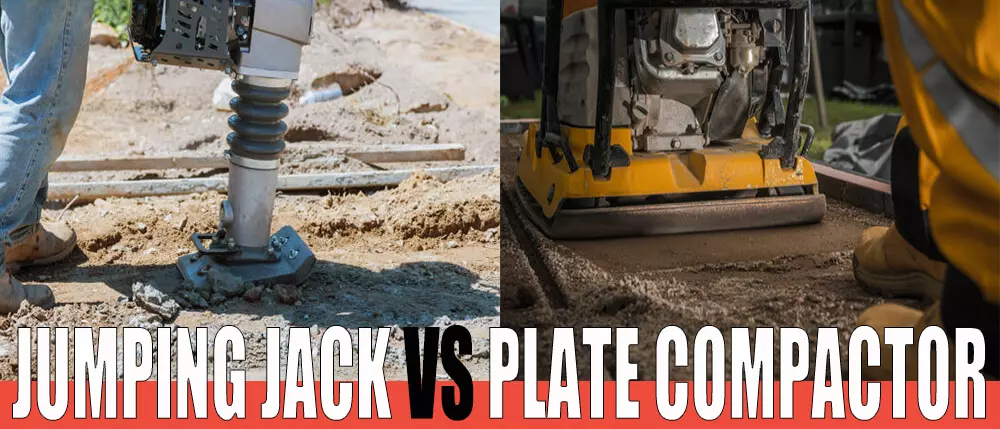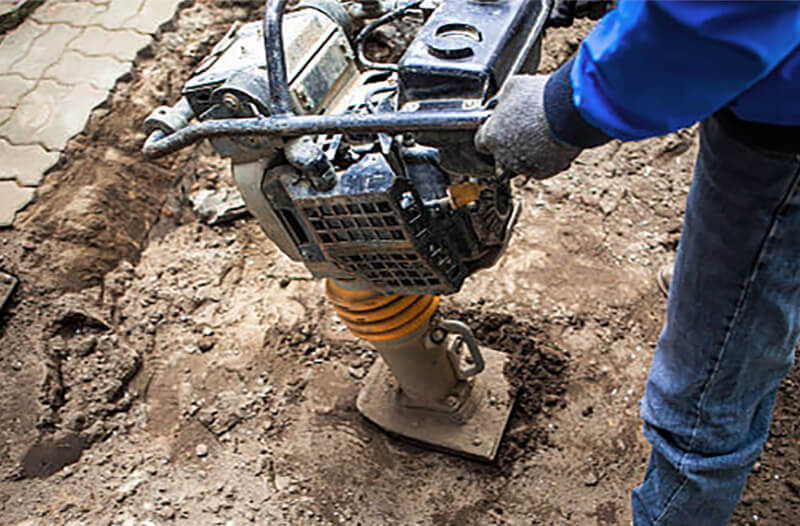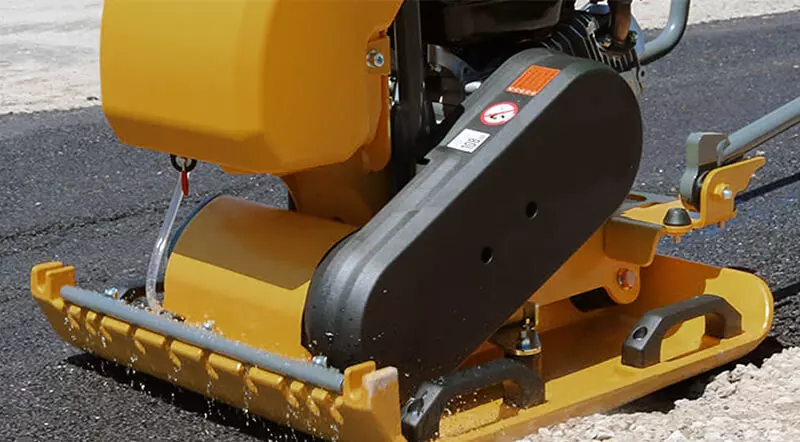10Jan 2024
table of contents

In the construction world, compaction is a critical process and two key tools stand out for this task – jumping jack and plate compactors. While both tools serve the basic purpose of compression, they differ in various ways and are designed for their own unique applications, which makes them both similar and different.
In this comprehensive review, BISON takes an in-depth look at how jumping jacks and plate compactors compare, taking into account fundamental factors such as size and weight, compaction intensity, maneuverability, cost, and energy consumption. Recognizing the differences in their usage domains, allows you to identify the best choice tailored to your specific needs.
In the end, you'll not only learn the key differences between these two types of compaction equipment, but you'll also gain insight into how to make an informed choice based on your unique needs, such as construction and road projects. Get ready for a sophisticated journey into soil compaction equipment. Follow BISON to learn about this compelling comparison. You won't want to miss it.
The jumping jack or tamping rammer is a time-tested tool in the field of compaction. Named for its unique "jumping" action, it utilizes an impact mechanism to deliver high impact energy to level uneven surfaces and increase the dry density of soil.
Due to its immense power, jumping jack excel at compacting sticky soils that require high energy input.
Its slender design allows it to maneuver in tight areas.
The jack has a high impact force that compacts the soil deeper, making it ideal for deep work.
It does not perform well on non-cohesive granular soils.
Due to the strenuous operation, prolonged use can cause operator fatigue.
Its impact mechanism involves multiple moving parts, so it may require more frequent maintenance.

In contrast, plate compactors use vibration forces to operate. Its flat, heavy steel plate generates high-frequency vibrations, making it an excellent tool for compacting granular soil.
Plate compactors are the champions of compacting granular soils.
Its operation can cover larger areas faster, saving valuable field time.
Its bulky size may hinder maneuverability in smaller spaces or around obstacles.
High frequency vibrations can cause damage to nearby structures due to the transmitted vibrations.
It may not achieve the same depth of compaction as jumping jacks.
Both jumping jacks and plate compactors have unique advantages and disadvantages. For more detailed differences, follow BISON to learn more!

Jumping jacks are typically designed with a narrow, tall build, typically standing about 40-50 inches tall and weighing between 140-200 pounds. Their slim layout helps them reach tight spaces efficiently and compact soil around obstacles. Plate compactors, on the other hand, have a wider construction with a base plate that is typically 15-25 inches wide and 20-25 inches long, depending on the model, and a weight range of 100-250 pounds. This design provides stability for smooth compaction of larger open areas, but its increased footprint may be limiting when working in tight spaces or in shipping and storage facilities. Ask about BISON jumping jacks and plate compactors!
With impact forces of up to 3,500 pounds per square foot, the jack provides greater compaction of deeper soil layers, often up to two feet. This allows them to effectively compact highly cohesive soils. In contrast, plate compactors typically operate via vibration, producing lower compaction forces in the 1000 - 2500 pounds per square foot range, but with a larger surface area and shallower depths, often up to a foot. This property makes it ideal for compacting granular or mixed soils.
When it comes to maneuverability, jumping jacks definitely lead the way due to their slim design. They are easier to maneuver in tricky, tight spaces. Additionally, their high-impact, straight-line operation allows them to maintain control even in highly cohesive soil situations. Plate compactors, on the other hand, have a larger base area and oscillating motion, which can provide better control on flat, open terrain, but you may find it cumbersome when maneuvering around obstacles or tight corners.
From a financial perspective, jumping jacks tend to have lower upfront costs. However, their high-impact operation often causes parts to wear out more frequently and maintenance costs increase over time. In addition, due to the high-frequency impact action of the jack, more fuel or electricity may be consumed. In contrast, plate compactors, while initially costing more, are less expensive to maintain due to their less vigorous vibrating operation. Additionally, their operation typically consumes less energy or fuel over time than skydiving, making them cost-effective when longevity and efficiency are considered.
Jumping jacks are primarily used for compaction tasks in trenches, around foundations, or in areas where highly cohesive soils such as clay and silt require deep compaction. They excel when the job involves dense, deep soil. Additionally, plate compactors are the equipment of choice for consolidating less cohesive soils such as sand and gravel. Their typical application scenarios include the creation of patios, driveways and pathways where smoothing and horizontal compaction of shallow soil layers is required.

The choice between a jumping jack and a plate compactor depends largely on the specific requirements of your application. In addition to cost and effort, here are some factors to consider when making your decision:
As mentioned before, soil type plays an important role in determining the right compactor. If you are working with clay soils and need to achieve deeper compaction, a high-impact jacking jack may be a better choice, which is designed to effectively compact cohesive, highly plastic soils such as clays and silts. Conversely, for granular soils that require compaction over large areas, vibrating plate compactors are generally more effective because they have less force but a wider range. Performs well in compacting low plasticity granular soils such as sand or gravel.
For small landscaping or trenching projects where space is limited, the jumping jack's narrow design provides greater maneuverability and the ability to work in confined spaces. If your project involves a large area or one where surface smoothness is a concern (such as driveways and parking lots), a plate compactor that can cover a wider range of sizes per pass is usually the best choice.
Due to its jump mechanism and higher vibration levels, operating a jumping jack may cause the user to tire more quickly, especially during prolonged use. In contrast, plate compactors offer a more comfortable user experience due to their stable vibration motion and often equipped handle vibration isolators, allowing for longer operating times without causing much fatigue.
Clearly, both jumping jacks and plate compactor machines offer unique advantages and ideal use cases, cementing their place in the construction world. jumping jacks excel at compacting sticky soil and working in tight spaces because of their slender design and high impact, while plate compactors use their vibrating power and wide base to work in large open spaces. Space and granular materials play a role.
However, selection of suitable compaction equipment should not rely purely on empirical comparisons. Need to match the right tool to the specific needs of the project, best choice hinges on several critical elements, like the level of compaction, area covered, type of soil, machine's durability, comfort for the operator, as well as costs and energy consumption.
Finally, if you’re looking for high-performance compaction equipment that will stand the test of time, BISON jumping jacks and plate compactors should be on your consideration list. Combining powerful efficiency with impressive durability, these compactors deliver reliable, best-in-class performance, ensuring they become a valuable addition to your construction equipment. Now is the best time to make the right choice for your project.
inquiry form here
BISON BLOG, All the latest news and views from Bison Machinery.